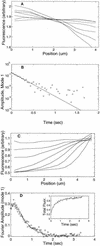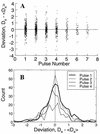Protein mobility in the cytoplasm of Escherichia coli
- PMID: 9864330
- PMCID: PMC103549
- DOI: 10.1128/JB.181.1.197-203.1999
Protein mobility in the cytoplasm of Escherichia coli
Abstract
The rate of protein diffusion in bacterial cytoplasm may constrain a variety of cellular functions and limit the rates of many biochemical reactions in vivo. In this paper, we report noninvasive measurements of the apparent diffusion coefficient of green fluorescent protein (GFP) in the cytoplasm of Escherichia coli. These measurements were made in two ways: by photobleaching of GFP fluorescence and by photoactivation of a red-emitting fluorescent state of GFP (M. B. Elowitz, M. G. Surette, P. E. Wolf, J. Stock, and S. Leibler, Curr. Biol. 7:809-812, 1997). The apparent diffusion coefficient, Da, of GFP in E. coli DH5alpha was found to be 7.7 +/- 2.5 microm2/s. A 72-kDa fusion protein composed of GFP and a cytoplasmically localized maltose binding protein domain moves more slowly, with Da of 2.5 +/- 0.6 microm2/s. In addition, GFP mobility can depend strongly on at least two factors: first, Da is reduced to 3.6 +/- 0.7 microm2/s at high levels of GFP expression; second, the addition to GFP of a small tag consisting of six histidine residues reduces Da to 4.0 +/- 2.0 microm2/s. Thus, a single effective cytoplasmic viscosity cannot explain all values of Da reported here. These measurements have implications for the understanding of intracellular biochemical networks.
Figures





References
MeSH terms
Substances
LinkOut - more resources
Full Text Sources
Other Literature Sources

